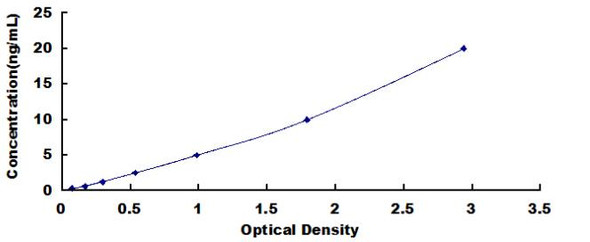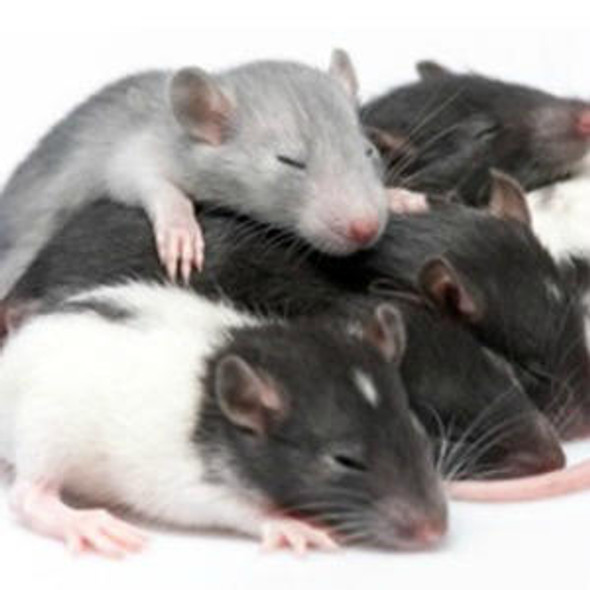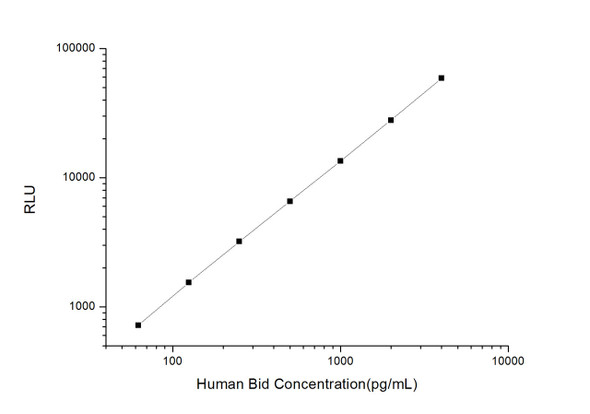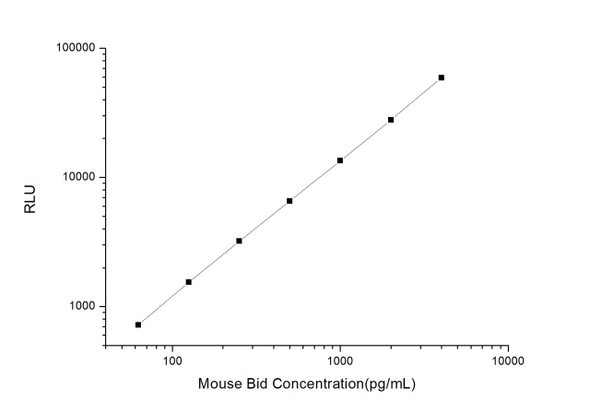Rat Signaling ELISA Kits 2
Rat BID (BH3 Interacting Domain Death Agonist) CLIA Kit (RTES00063)
- SKU:
- RTES00063
- Product Type:
- ELISA Kit
- ELISA Type:
- CLIA Kit
- Size:
- 96 Assays
- Sensitivity:
- 37.5pg/mL
- Range:
- 62.5-4000pg/mL
- ELISA Type:
- Sandwich
- Reactivity:
- Rat
- Sample Type:
- Serum, plasma and other biological fluids
- Research Area:
- Cell Death
Description
| Assay type: | Sandwich |
| Format: | 96T |
| Assay time: | 4.5h |
| Reactivity: | Rat |
| Detection method: | Chemiluminescence |
| Detection range: | 62.50-4000 pg/mL |
| Sensitivity: | 37.50 pg/mL |
| Sample volume: | 100µL |
| Sample type: | Serum, plasma and other biological fluids |
| Repeatability: | CV < 15% |
| Specificity: | This kit recognizes Rat BID in samples. No significant cross-reactivity or interference between Rat BID and analogues was observed. |
This kit uses Sandwich-CLIA as the method. The micro CLIA plate provided in this kit has been pre-coated with an antibody specific to Rat Bid. Standards or samples are added to the appropriate micro CLIA plate wells and combined with the specific antibody. Then a biotinylated detection antibody specific for Rat Bid and Avidin-Horseradish Peroxidase (HRP) conjugate are added to each micro plate well successively and incubated. Free components are washed away. The substrate solution is added to each well. Only those wells that contain Rat Bid, biotinylated detection antibody and Avidin-HRP conjugate will appear fluorescence. The Relative light unit (RLU) value is measured spectrophotometrically by the Chemiluminescence immunoassay analyzer. The RLU value is positively associated with the concentration of Rat Bid. The concentration of Rat Bid in the samples can be calculated by comparing the RLU of the samples to the standard curve.
| UniProt Protein Function: | BID: a pro-apoptotic member of the Bcl-2 superfamily. Targets intracellular membranes and contains a BH3 death domain. Heterodimerizes with either the pro-apoptotic protein BAX or the anti-apoptotic protein BCL2, antagonizing its protective effect. The activity of BID is regulated by Caspase 8-mediated cleavage, exposing the BH3 domain and significantly changing the surface charge and hydrophobicity, causing translocation to mitochondria where it triggers cytochrome c release. Multiple alternatively spliced variants have been found. |
| UniProt Protein Details: | Protein type:Apoptosis; Mitochondrial Cellular Component: mitochondrion; membrane; cell; cytoplasm; intracellular; cytosol Molecular Function:protein binding; ubiquitin protein ligase binding Biological Process: caspase activation; positive regulation of protein oligomerization; release of cytochrome c from mitochondria; apoptotic mitochondrial changes; positive regulation of apoptosis; positive regulation of protein homooligomerization; regulation of protein oligomerization; brain development; protein targeting to mitochondrion; protein homooligomerization; response to estradiol stimulus; regulation of cell proliferation |
| NCBI Summary: | involved in inducing Bax oligomerization in isolated mitochondrial outer membranes [RGD, Feb 2006] |
| UniProt Code: | Q9JLT6 |
| NCBI GenInfo Identifier: | 12083631 |
| NCBI Gene ID: | 64625 |
| NCBI Accession: | NP_073175. 1 |
| UniProt Secondary Accession: | Q9JLT6,Q9JK60, |
| UniProt Related Accession: | Q9JLT6 |
| Molecular Weight: | 22,249 Da |
| NCBI Full Name: | BH3-interacting domain death agonist |
| NCBI Synonym Full Names: | BH3 interacting domain death agonist |
| NCBI Official Symbol: | Bid |
| NCBI Protein Information: | BH3-interacting domain death agonist |
| UniProt Protein Name: | BH3-interacting domain death agonist |
| UniProt Synonym Protein Names: | p22 BID; BID |
| Protein Family: | Bidirectional sugar transporter |
| UniProt Gene Name: | Bid |
| UniProt Entry Name: | BID_RAT |
As the RLU values of the standard curve may vary according to the conditions of the actual assay performance (e. g. operator, pipetting technique, washing technique or temperature effects), the operator should establish a standard curve for each test. Typical standard curve and data is provided below for reference only.
| Concentration (pg/mL) | RLU | Average | Corrected |
| 4000 | 55915 62247 | 59081 | 59046 |
| 2000 | 27020 28698 | 27859 | 27824 |
| 1000 | 13998 12970 | 13484 | 13449 |
| 500 | 6362 6848 | 6605 | 6570 |
| 250 | 3260 3226 | 3243 | 3208 |
| 125 | 1621 1541 | 1581 | 1546 |
| 62.50 | 746 764 | 755 | 720 |
| 0 | 34 36 | 35 | -- |
Precision
Intra-assay Precision (Precision within an assay): 3 samples with low, mid range and high level Rat BID were tested 20 times on one plate, respectively.
Inter-assay Precision (Precision between assays): 3 samples with low, mid range and high level Rat BID were tested on 3 different plates, 20 replicates in each plate.
| Intra-assay Precision | Inter-assay Precision | |||||
| Sample | 1 | 2 | 3 | 1 | 2 | 3 |
| n | 20 | 20 | 20 | 20 | 20 | 20 |
| Mean (pg/mL) | 193.60 | 388.58 | 1663.36 | 196.33 | 390.33 | 1537.44 |
| Standard deviation | 20.68 | 41.58 | 122.09 | 17.96 | 36.81 | 171.27 |
| C V (%) | 10.68 | 10.70 | 7.34 | 9.15 | 9.43 | 11.14 |
Recovery
The recovery of Rat BID spiked at three different levels in samples throughout the range of the assay was evaluated in various matrices.
| Sample Type | Range (%) | Average Recovery (%) |
| Serum (n=5) | 94-110 | 101 |
| EDTA plasma (n=5) | 100-111 | 105 |
| Cell culture media (n=5) | 86-100 | 93 |
Linearity
Samples were spiked with high concentrations of Rat BID and diluted with Reference Standard & Sample Diluent to produce samples with values within the range of the assay.
| Serum (n=5) | EDTA plasma (n=5) | Cell culture media (n=5) | ||
| 1:2 | Range (%) | 87-100 | 90-104 | 84-100 |
| Average (%) | 92 | 96 | 91 | |
| 1:4 | Range (%) | 87-100 | 103-115 | 92-108 |
| Average (%) | 94 | 108 | 98 | |
| 1:8 | Range (%) | 95-106 | 84-98 | 95-107 |
| Average (%) | 100 | 91 | 100 | |
| 1:16 | Range (%) | 88-104 | 88-98 | 90-106 |
| Average (%) | 95 | 93 | 97 |
An unopened kit can be stored at 4°C for 1 month. If the kit is not used within 1 month, store the items separately according to the following conditions once the kit is received.
| Item | Specifications | Storage |
| Micro CLIA Plate(Dismountable) | 8 wells ×12 strips | -20°C, 6 months |
| Reference Standard | 2 vials | |
| Concentrated Biotinylated Detection Ab (100×) | 1 vial, 120 µL | |
| Concentrated HRP Conjugate (100×) | 1 vial, 120 µL | -20°C(shading light), 6 months |
| Reference Standard & Sample Diluent | 1 vial, 20 mL | 4°C, 6 months |
| Biotinylated Detection Ab Diluent | 1 vial, 14 mL | |
| HRP Conjugate Diluent | 1 vial, 14 mL | |
| Concentrated Wash Buffer (25×) | 1 vial, 30 mL | |
| Substrate Reagent A | 1 vial, 5 mL | 4°C (shading light) |
| Substrate Reagent B | 1 vial, 5 mL | 4°C (shading light) |
| Plate Sealer | 5 pieces | |
| Product Description | 1 copy | |
| Certificate of Analysis | 1 copy |
- Set standard, test sample and control (zero) wells on the pre-coated plate and record theirpositions. It is recommended to measure each standard and sample in duplicate. Note: addall solutions to the bottom of the plate wells while avoiding contact with the well walls. Ensuresolutions do not foam when adding to the wells.
- Aliquot 100µl of standard solutions into the standard wells.
- Add 100µl of Sample / Standard dilution buffer into the control (zero) well.
- Add 100µl of properly diluted sample (serum, plasma, tissue homogenates and otherbiological fluids. ) into test sample wells.
- Cover the plate with the sealer provided in the kit and incubate for 90 min at 37°C.
- Aspirate the liquid from each well, do not wash. Immediately add 100µL of BiotinylatedDetection Ab working solution to each well. Cover the plate with a plate seal and gently mix. Incubate for 1 hour at 37°C.
- Aspirate or decant the solution from the plate and add 350µL of wash buffer to each welland incubate for 1-2 minutes at room temperature. Aspirate the solution from each well andclap the plate on absorbent filter paper to dry. Repeat this process 3 times. Note: a microplatewasher can be used in this step and other wash steps.
- Add 100µL of HRP Conjugate working solution to each well. Cover with a plate seal andincubate for 30 min at 37°C.
- Aspirate or decant the solution from each well. Repeat the wash process for five times asconducted in step 7.
- Add 100µL of Substrate mixture solution to each well. Cover with a new plate seal andincubate for no more than 5 min at 37°C. Protect the plate from light.
- Determine the RLU value of each well immediately.






